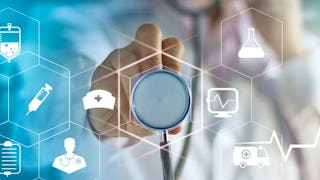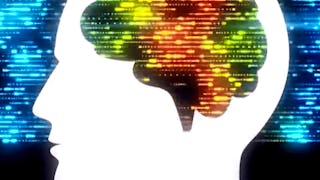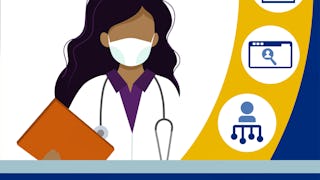In this class, we present a broad overview of the field of medical software. You will learn from Yale professors and a series of industry experts who connect the course concepts to their real world applications.


Introduction to Medical Software

Instructor: Xenophon Papademetris
33,332 already enrolled
Included with
(281 reviews)
Recommended experience
What you'll learn
How medical devices and software are regulated around the world. How medical software is designed, developed, and implemented in the real world.
Skills you'll gain
- Artificial Intelligence and Machine Learning (AI/ML)
- Verification And Validation
- Medical Management
- User Research
- Healthcare Project Management
- Medical Privacy
- Software Testing
- Risk Management
- Clinical Trials
- Regulatory Affairs
- Human Factors
- Regulatory Requirements
- Systems Development
- User Interface (UI)
- Software Development Life Cycle
- Medical Devices
- Quality Management Systems
- Software Design
- Entrepreneurship
- Usability
Details to know

Add to your LinkedIn profile
11 assignments
See how employees at top companies are mastering in-demand skills

There are 14 modules in this course
Welcome to week one of our Introduction to Medical Software class. Here we will set the set the stage for what will come in the rest of the course. This week will introduce what medical software is, and we will discuss relevant regulatory issues. We will also dive into the opportunities in medical software and digital health, and finally we will discuss the regulatory process and the US health care environment.
What's included
7 videos4 readings1 assignment
Welcome to week two of our introduction to Medical Software class. Our focus is this week is going to be on the regulatory aspects of medical software. What are the procedures one must follow? What is the process that they follow? We will discuss some emerging issues when it comes to things like artificial intelligence and machine learning. Lectures will discuss the history of medical device regulation and the history of the Food and Drug Administration in the United States. We will also take a look at the regulatory environment in the EU and China.
What's included
6 videos6 readings1 assignment
Welcome to week three of our introduction to Medical Software class. In this week's lectures, we will look at the clinical environment and the constraints that come with it. We will look at constraints that come from the environment itself, the stakeholders involved, and also the associated technology that is present there, the databases that we have to interact with, the electronic health records, the parks, the imaging databases, and then issues to do with the regulations that are in this area regarding data privacy and security issues, and the increasing emphasis on cybersecurity.
What's included
6 videos5 readings1 assignment
In this week’s lectures we will talk about two management technologies that support the development of medical software: quality management systems and risk management.
What's included
6 videos2 readings1 assignment
This week, we will start looking at the design of software and introduce the medical software life cycle. In particular, we will introduce the international standard for medical software life cycles IEC 62304 and provide a guided tour of the process. We will also introduce our example project which we will use to anchor our discussions over the next few weeks.
What's included
5 videos4 readings1 assignment
In this week's segments, we will focus on user needs and the system requirements specification process. We will discuss how to identify user needs and how to communicate with medical experts. In the second half of this week's segments, we will describe the systems requirements specification document and present an example outline of such a document for our image guided neurosurgery project.
What's included
6 videos1 reading1 assignment
This week, we will primarily focus on the process of designing the software, i.e. the creation of a plan that will allows us to from requirements to something that now can be implemented on a computer. We will also discuss usability engineering -- the process of designing user interfaces to improve ease-of-use and to avoid user errors. Finally, we have a segment from Dr. Licholai on Digital Behavioral Health to give you an example of a use case for medical software.
What's included
5 videos4 readings1 assignment
In this week, we get to the most concrete components of the medical software lifecycle, coding and testing. In many ways, this is the part of the lifecycle that is most similar to any other kind of software engineering you may have had exposure to. We will present some advice on coding, especially in the medical software domain and introduce source code management. In the second half of this week's content, we will introduce software testing and discuss what a testing plan looks like.
What's included
5 videos1 reading1 assignment
This week, we will take a detour from the software lifecycle process to cover some mathematical background before returning to the software lifecycle next week when we talk about software validation. The goal of this week is to introduce key concept from probability and statistics. We will talk about the critical area of signal detection, and then we will present some methods that are necessary to understand how clinical trials are designed.
What's included
8 videos2 readings1 assignment
This week, we will cover the last steps in the medical software lifecycle. We will spend most of our time talking about validation, where we will also present a brief introduction to clinical trials. We will also have short segments discussing deployment, maintenance, and retirement.
What's included
5 videos3 readings1 assignment
In this week's lectures, we focus on artificial intelligence and machine learning, the use of this technology, the challenges they produce as we integrate them into software, and the challenges of regulating these technologies in order to protect patients and caregivers.
What's included
6 videos7 readings1 assignment
In this section of our course, we will step away from the technical aspects that you have been learning and really think about how to get your medical software or your lab prototype out into the hands of people in the real world. For those of you interested in enterpreneurship, it is just as important to get an basic overview of the business side of things so that you can launch your venture. First, we will discuss the changing models in health care. Then we will go into the nuts and bolts of starting a new health care venture, a broad overview to speak. And then we will end with when and how to raise capital.
What's included
5 videos7 readings
In this optional supplementary module we will present examples of what happens when software development goes wrong. When this class is taught at Yale, the students are assigned to present these (and other) case studies in small groups. We follow this tradition for the online class as the case studies will be presented by the four Yale undergraduate students who worked as student assistants in the creation of this online course.
What's included
4 videos9 readings
Throughout the creation of this course, Prof. Papademetris conducted interviews with an array of industry experts. Many of these conversations apply to multiple of the weeks' topics - please take a look and enjoy!
What's included
1 reading
Instructor

Offered by
Explore more from Design and Product
 Status: Free
Status: FreeAmazon Web Services
 Status: Preview
Status: PreviewUniversity of Florida

The Cleveland Clinic Foundation
 Status: Free Trial
Status: Free TrialJohns Hopkins University
Why people choose Coursera for their career




Learner reviews
281 reviews
- 5 stars
84.34%
- 4 stars
12.81%
- 3 stars
1.06%
- 2 stars
0%
- 1 star
1.77%
Showing 3 of 281
Reviewed on Mar 11, 2024
Outstanding organization & content throughout this course.I would be very interested in an advanced or complementary offering from Yale in the Bioinformatics space.Thank you so much, Yale Online!!
Reviewed on Aug 27, 2023
This is the best course for those who wants to know all about medical devices, and their related regulations.
Reviewed on Oct 3, 2024
Prof X. Papademetris is excellent teacher, to the point, clear and precise. The content of this course is perfect for a newbie in the field. Thank you, Coursera, for a wonderful treat.

Open new doors with Coursera Plus
Unlimited access to 10,000+ world-class courses, hands-on projects, and job-ready certificate programs - all included in your subscription
Advance your career with an online degree
Earn a degree from world-class universities - 100% online
Join over 3,400 global companies that choose Coursera for Business
Upskill your employees to excel in the digital economy
Frequently asked questions
To access the course materials, assignments and to earn a Certificate, you will need to purchase the Certificate experience when you enroll in a course. You can try a Free Trial instead, or apply for Financial Aid. The course may offer 'Full Course, No Certificate' instead. This option lets you see all course materials, submit required assessments, and get a final grade. This also means that you will not be able to purchase a Certificate experience.
When you purchase a Certificate you get access to all course materials, including graded assignments. Upon completing the course, your electronic Certificate will be added to your Accomplishments page - from there, you can print your Certificate or add it to your LinkedIn profile.
Yes. In select learning programs, you can apply for financial aid or a scholarship if you can’t afford the enrollment fee. If fin aid or scholarship is available for your learning program selection, you’ll find a link to apply on the description page.
More questions
Financial aid available,

